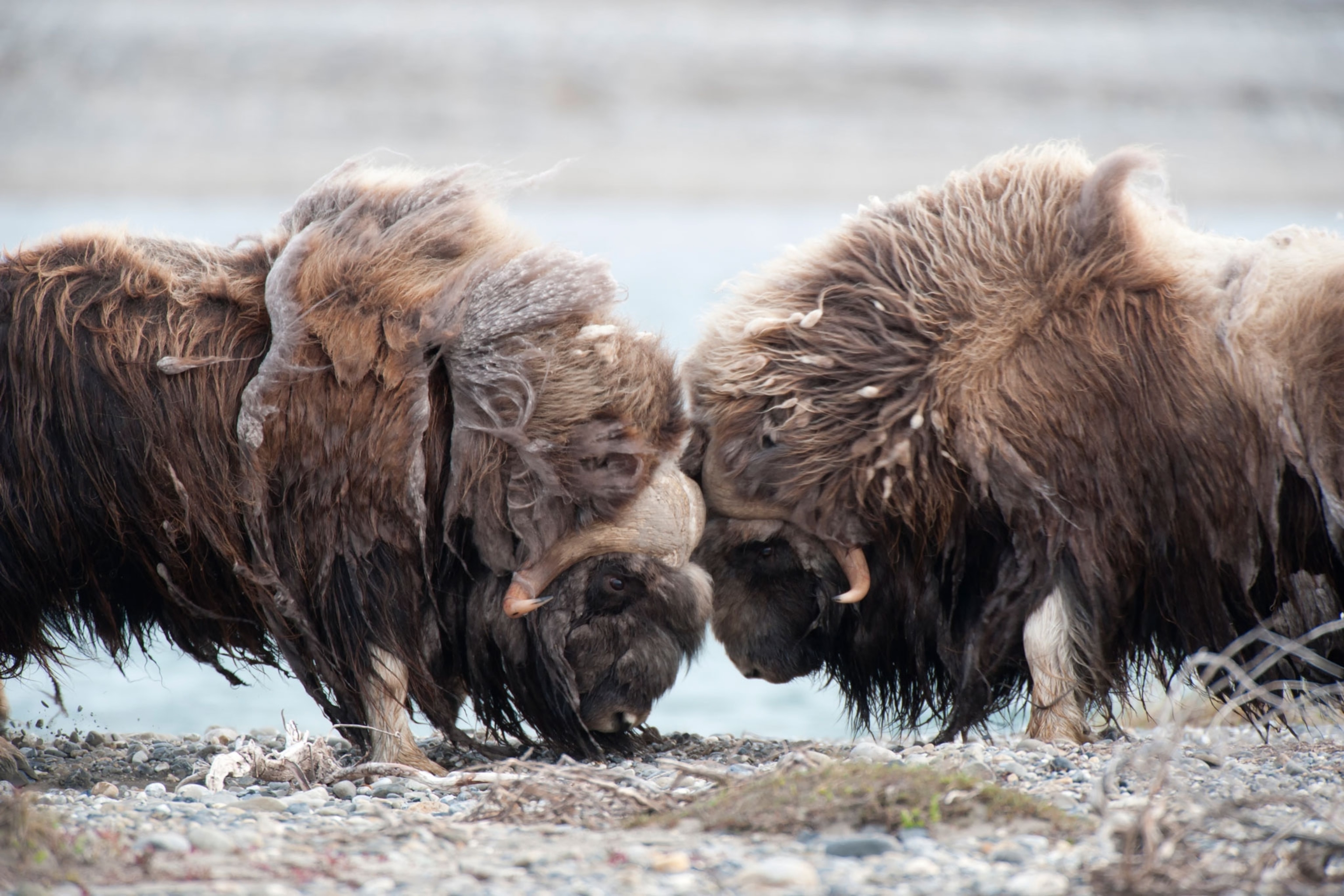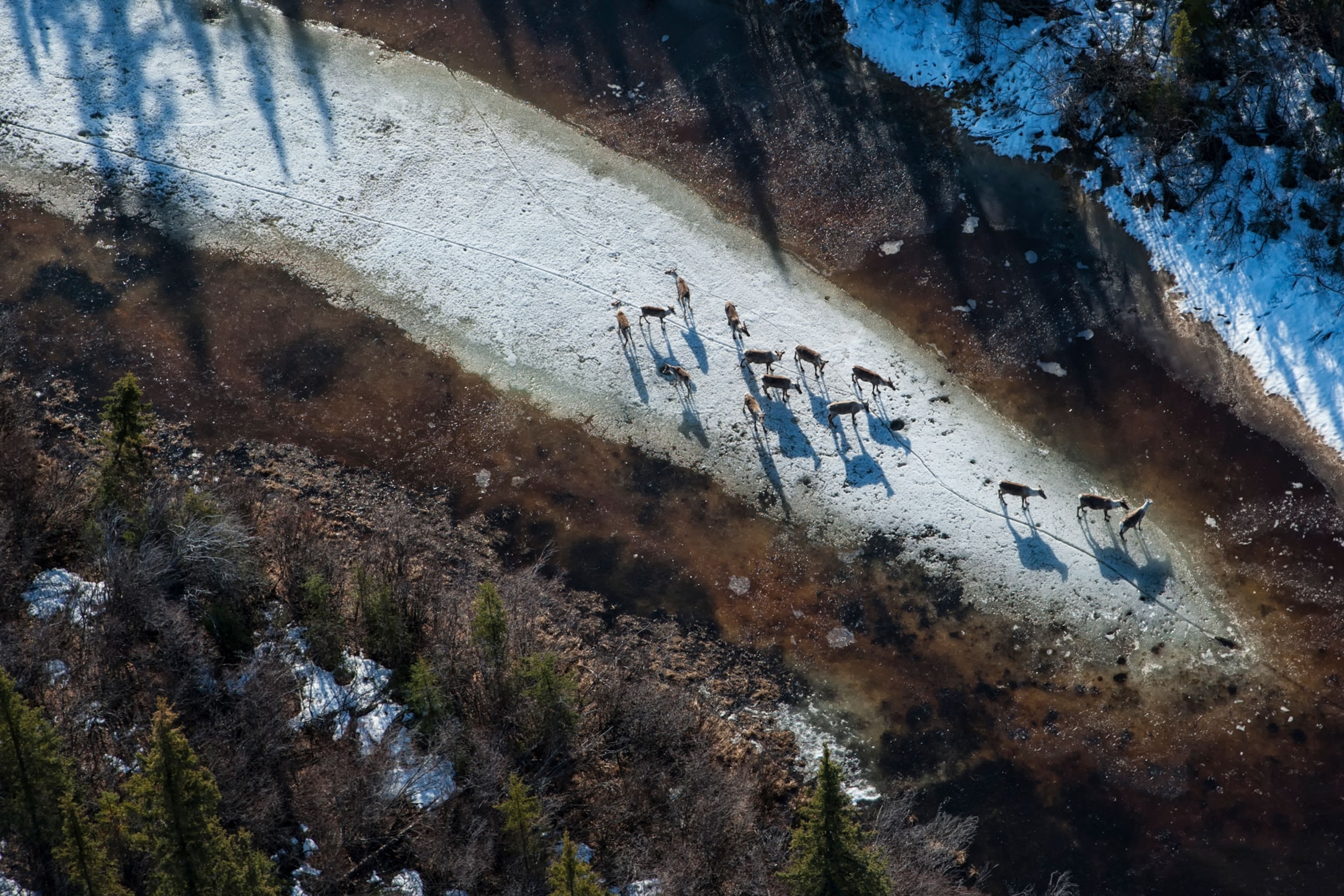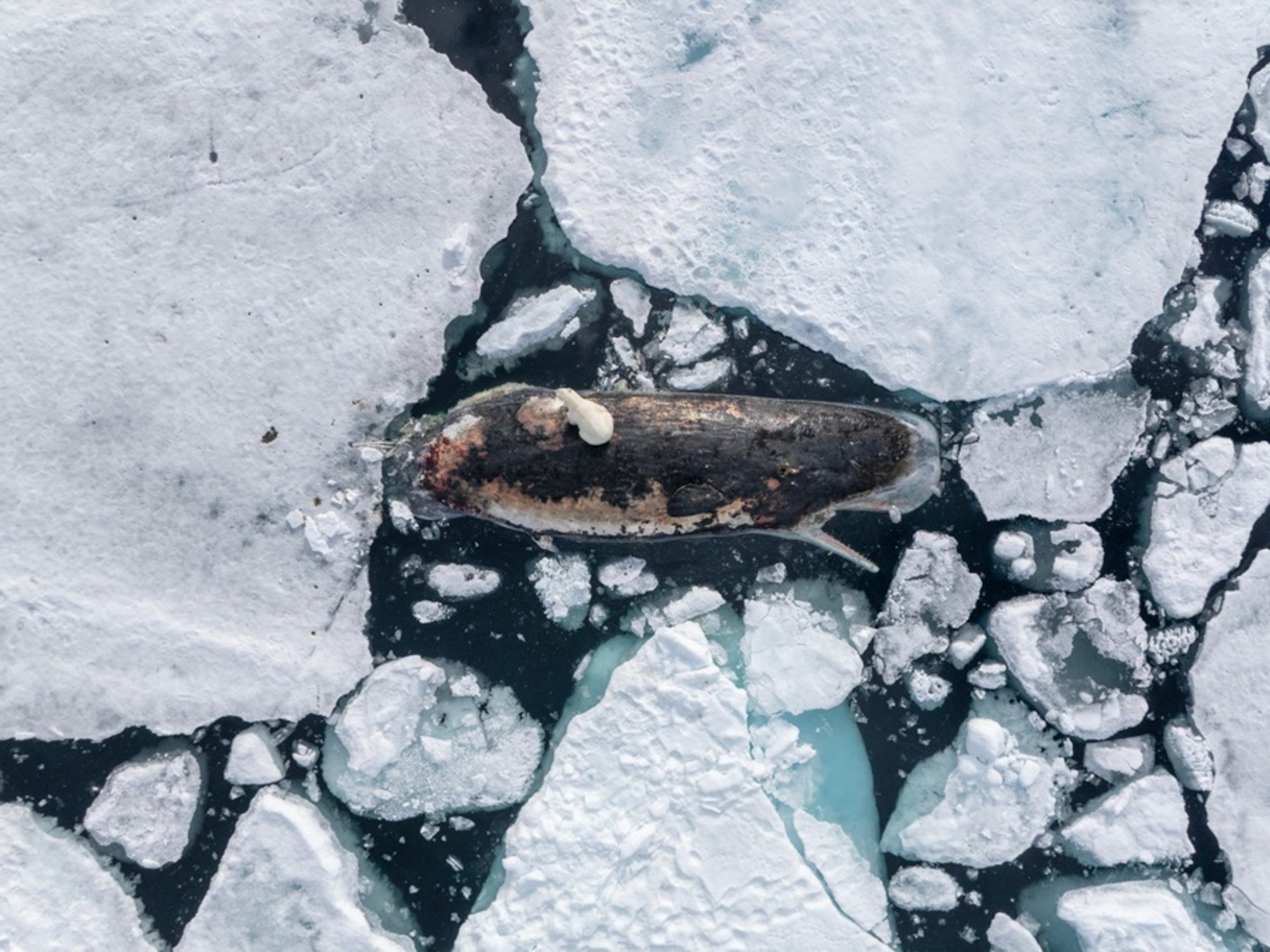
Arctic Refuge Has Lots of Wildlife—Oil, Maybe Not So Much
After four decades of debate, Congress looks set to open the Arctic National Wildlife Refuge in Alaska to oil drilling.
There are few places left on the planet that remain unscathed by the heavy footprint of humanity. The 19.6-million-acre Arctic National Wildlife Refuge, in the northeast corner of Alaska, is one of them—a vast primordial wilderness that stretches from spruce forests in the south, over the jagged Brooks Range, onto gently sloping wetlands that flow into the ice-curdled Beaufort Sea. ANWR is the summer breeding ground of nearly 200,000 caribou, the winter den of dozens of polar bears, and the gathering place of millions of migratory birds that descend upon it each spring from every flyway in North America.
Now it may soon be home to oil wells, gravel roads, air strips, oil camps, and all the infrastructure they entail.
On Tuesday, December 19, the U.S. House passed the Republican tax reform bill; the Senate was expected to vote on it soon. Last Thursday, Senator Lisa Murkowski (R-Alaska) announced that the bill had survived a House-Senate conference committee with her pet project intact: a rider that would open the refuge’s long-contested coastal plain to oil rigs.
The U.S. Geological Survey (USGS) estimates the area could contain 4.3 billion to 11.8 billion barrels of technically recoverable oil. The higher figure, which USGS gives only a five percent probability, would put ANWR in the range of Prudhoe Bay, one of the largest oil discoveries in North America.
"We raise…more than one billion dollars over the next 10 years, and once production begins it will likely raise more than $100 billion for the federal treasury," Murkowski told the conference committee on Thursday. "None of this comes at the expense of the environment."
Critics of the move disagree on both the benefits and the costs.
"The numbers don't add up whatsoever," says Jamie Williams, president of The Wilderness Society, whose predecessor, the legendary field biologist Olaus Murie, helped draw the boundaries of ANWR’s predecessor, the Alaska Wildlife Range, in the 1950s. "The whole notion that you are going to trim a trillion-dollar deficit with phony oil revenue is just a cynical political ploy. This is a backdoor gimmick done in the dark of the night to achieve a political goal at the expense of a place this country has protected for half a century. The majority of Americans don't want to see ANWR industrialized."

Conflicting Views
The fight over drilling has been going on since the 19.6-million-acre refuge was created in 1980, three-years after the Trans-Alaska Pipeline started carrying oil from Prudhoe Bay to Valdez, and oil money started gushing into the state. Most of ANWR was designated as protected wilderness area with no development allowed. But in section 1002 of the legislation, Congress specifically set aside 1.5 million acres on the coastal plain with the greatest hydrocarbon potential. The law authorized seismic studies in the “1002 area,” but left its ultimate fate for future Congresses to decide—thus creating one of the longest-running environmental controversies in modern American history.
In the years since, Alaska Republicans—including Murkowski's father, the late Senator Frank Murkowski—have repeatedly tried and failed to open the refuge to drilling. This time, however, is different: The drilling provision is attached to a budget reconciliation bill that the Senate can approve by simple majority—no Democratic votes required—and to a $1.5 trillion tax cut that Republicans are extremely keen to pass.
Under the bill, the federal government and Alaska would evenly split any revenue generated by oil lease sales and royalties in the refuge—about $1.1 billion a piece in the first decade, according to a Congressional Budget Office projection. In Alaska, the money would help stem ballooning budget deficits that have plagued the state since the price of oil plummeted in 2015.
Alaska is the Venezuela of the United States: In most years more than 80 percent of its budget comes from oil and gas taxes and royalties. On the North Slope, where government jobs, schools, health clinics, and infrastructure are largely funded by property taxes on the oil industry, most—but not all—of the nearly 10,000 residents favor opening ANWR to drilling.
"The 1002 area was specifically set aside for exploration by Congress," said Rex Rock Sr., president and CEO of the Arctic Slope Regional Corporation, in a statement released last week. The Inupiat native corporation is heavily vested in the oil industry. "A clear majority of the people of the North Slope support responsible development in ANWR; they should have the same rights to economic self-determination as people in the rest of the United States."

Visions of Prudhoe
At the federal level, $1.1 billion would offset less than one tenth of one percent of the $1.5 trillion tax cut. To raise even that much, the two lease sales envisioned by the bill over the next decade, of around 400,000 acres each, would have to bring in $2,750 per acre—yet lease sales elsewhere on the North Slope have been averaging less than a tenth of that. The top bids for a sale earlier this month were $15 per acre. An independent analysis done for the left-leaning Center for American Progress estimated that revenue from ANWR would net only $37.5 million to federal coffers over the next decade.
As for the whopping $100 billion in federal revenues that both Murkowski and the Trump Administration have projected for the decades to come—that forecast presumably rests on a couple of rosy assumptions. First, that the price of oil, now fluctuating around $60 a barrel, will rise in the long-term above $78—the current break-even price for drilling on the North Slope. And second, that the 1002 area holds a minimum of 7 billion barrels, the mean of the USGS range of estimates.
The USGS estimates are based on seismic surveys from 1984 and 1985. Those low-quality data have since been reanalyzed several times with better computers, and the findings have shifted each time. First there was a large pool of oil on the east side of the 1002 area; then it moved to the west side. Most recently the USGS has decided there’s probably no large pool at all, and whatever oil there is in ANWR is likely scattered across the coastal plain in as many as 35 small traps.
“The geology there is unlike anything that has been penetrated to the west,” says David Houseknecht, a senior researcher with USGS, who helped prepare the most recent estimate in 2001. “We do not believe there is another Prudhoe Bay-like feature in the 1002 area. Industry gave up on pursuing those traps in the 1980s.”
The only way to truly know what's in a formation, of course, is to stick a drill bit in it. So far the wells that have been drilled close to ANWR have been disappointing at best and dry at worst. The one exception is the Point Thompson field, right next to the refuge. Last year it started pumping a few thousand barrels a day of natural gas liquids down the Trans-Alaska Pipeline, providing a much-needed trickle of revenue to Alaska (which had sued to force ExxonMobil to develop the field). Point Thompson is a huge deposit of natural gas. Eventually Exxon and the state hope to export it to Asia.
Only one well has ever been drilled in the 1002 area itself, on land owned by the Kaktovic Inupiat Corporation. The well was drilled by a consortium of oil companies in 1986 into what was believed to be the most promising geologic trap. The results have long been kept secret. But as National Geographic reported in 2006, it was a disappointment, according to sources familiar with the well data. Another test well, known as Aurora, was drilled just offshore into the same formation; those data are public, and it too was a dry hole.

Even with the incredible technology used by the oil industry today, oil exploration remains a lottery—a lesson Shell learned the hard way after spending $7 billion to drill a dry hole in the Chukchi Sea off Alaska in 2015.
The Costs
The environmental costs of drilling in the country's largest and wildest refuge are uncertain too. For drilling opponents, however, they would certainly be far too great.
The ANWR coastal plain hosts the highest density of polar bear dens in Alaska. As climate change shrinks sea ice, even more bears will be forced to build their snow dens onshore, say biologists.
Caribou seem more bothered by oil development than polar bears, and the Porcupine caribou herd—an important source of food for many native Alaskans and First Nation peoples in Canada—has calved in the 1002 area for thousands of years. In the early 1990s, state biologists with the Alaska Department of Fish and Game found that calf survival was very high on the coastal plain, and very low when the caribou were displaced further south or east—as oil development in ANWR would tend to do. The government of Canada actually issued a statement opposing drilling in the refuge, reminding the Trump Administration that the two nations signed a 1987 agreement to protect the Porcupine herd and its habitat.
Whatever damage is done in ANWR will persist a long time. A study by the National Academies of Science in 2003 concluded that it would be unlikely for oil and gas infrastructure ever to be removed from the North Slope, or for the land to be restored, due to the enormous cost. In the case of the single unsuccessful well drilled in ANWR in the 1980s, the oil companies did remove their equipment from the pad—but satellite images show the tundra has yet to recover, 30 years later.
"It really boils down to who we are as a nation," says the Wilderness Society's Williams. "Are we a nation that sells its soul for short-term profit at the expense of everything else? Especially during a time of surplus, when there are far cheaper and better places to drill. Or are we a nation that protects our natural heritage for future generations? This country has been defined by its wild places. If we allow drilling in the refuge, what's next? Condos in the Grand Canyon?"
For some native Alaskans, the issue is not even about money or oil. The Gwich'in have long depended on the Porcupine caribou herd that calves on the refuge's coastal plain. To them, the 1002 area is "the sacred place where life begins." They have fought drilling in the refuge for decades
"We stand firm against development in the Arctic National Wildlife Refuge," says Bernadette Demientieff, Executive Director of the Gwich'in Steering Committee in Fairbanks. "This is going to have a huge negative impact on our way of life and is a violation of our human rights. This is just the beginning of the fight, it is definitely not the end. We will be gearing up our people to continue to defend what is sacred to us."








